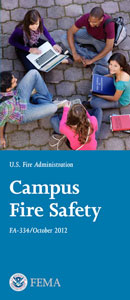The U.S. Fire Administration reviews and collects resources that can be used in public outreach activities to keep college students safe from on- and off-campus housing fires. Explore these materials to learn more about discussing fire safety with students, their parents, and campus housing administrators and staff.
This new campaign encourages parents to make sure off-campus housing is fire-safe before signing a lease for their child. Information includes a video public service announcement, fire statistics, and an off-campus housing fire safety checklist.
#OffCampusFire
This campaign is sponsored by Campus Firewatch, the U.S. Consumer Product Safety Commission, the National Fire Protection Association, and the U.S. Fire Administration.
From January 2000 to May 2015, there were 85 fatal fires in dormitories, fraternities, sororities and off-campus housing, resulting in 118 fatalities — an average of approximately seven per school year.
94 percent of fatal campus fires occurred off-campus.
Smoking (29 percent) was the leading cause of fatal campus fires.
Alcohol was a factor in 76 percent of fatal campus fires.
Smoke alarms were either missing or tampered with (disconnected or battery removed) in 58 percent of fatal campus fires.
Report audience: college and university fire and safety officials, fire and emergency service organizations
This report presents findings from a study that looked at data from fatal campus fires and the fatalities that resulted from them. Factors leading to the fire deaths of college students are highlighted to help officials plan programs that will prevent fire injuries and deaths on college campuses in the future.
Download the report PDF 2.8 MB

Download these free handouts on preventing on- and off-campus fires to reproduce and distribute in your community.

Set of 10 campus fire safety flyers. Includes tips for alcohol, smoking and cooking fire safety. PDF, 5.3 MB

Campus fire safety flyer with tips for parents PDF, 754 KB

Campus fire safety brochure with tips for students Free order or download
There are several specific causes for fires on in on- and off-campus college housing, including cooking, candles, smoking and overloaded power strips. For most students, the last fire safety training they received was in grade school, but with new independence comes new responsibilities. It is important that both off-campus and on-campus students know their fire risks and prevention actions that could save their lives.
Copy and paste these messages to your social media accounts and ask your followers to share.
Click on or touch an image below to display its full size and save it to your device.
The Exchange serves as a centralized location for national, state and local fire prevention and life safety practices and public education materials that organizations may wish to share with other communities. Visit the Exchange
The U.S. Fire Administration recommends the following organizations as trusted and reliable sources for free outreach materials you can use to help increase awareness about campus fires in your community.